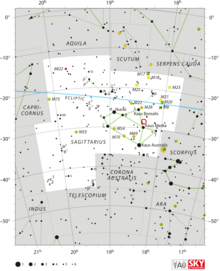astro.wikisort.org - Star
V5856 Sagittarii, also known as Nova Sagittarii 2016 Number 4, was the 4th and brightest nova that occurred in the constellation Sagittarius during 2016. It was discovered by the All Sky Automated Survey for SuperNovae (which assigned to it the name ASASSN-16ma) on 25.02 October 2016, at which time it had an apparent visual magnitude of 13.7.[7] It was independently discovered by Yukio Sakurai of Mito, Ibaraki, Japan on 26.38 October 2016, by which time it had reached magnitude 10.4.[8] It reached its peak brightness of magnitude 5.4, making it visible to the naked eye, on 8 November 2016.[4] The nova occurred within a region of the sky monitored by the OGLE microlensing experiment, and that group reported that no star brighter than magnitude 22 (I band) was seen at the nova's position prior to its eruption.[1]
 V5856 Sagittarii (left of center, circled in red) near its peak brightness and Venus (lower right) | |
| Observation data Epoch J2000 Equinox J2000 | |
|---|---|
| Constellation | Sagittarius |
| Right ascension | 18h 20m 52.25s[1] |
| Declination | −28° 22′ 12.1″[1] |
| Apparent magnitude (V) | 5.4 – <22[2] |
| Characteristics | |
| Variable type | Nova[3] |
| Astrometry | |
| Distance | 4200+1200 −900[4] pc |
| Other designations | |
| Database references | |
| SIMBAD | data |

V5856 Sagittarii declined from peak brightness rapidly, fading by 2 magnitudes in 11.3 days, and 3 magnitudes in 14.5 days.[9] It is therefore classified as a "fast" nova in the classification scheme of Cecilia Payne-Gaposchkin.[10] The nova showed two peaks: a "fireball" peak corresponding to the freely expanding material ejected from the eruption and, nearly a week later, a second brighter peak coincident in time with the detection of γ-rays from the nova by Fermi-LAT. The fireball peak occurred at different times depending upon the wavelength of light being observed, but the second peak occurred at the same time for all wavelengths.[11]

All novae are binary stars, with a "donor" star orbiting a white dwarf. The two stars are so close to each other that matter is transferred from the donor to the white dwarf. In the case of V5856 Sagittarii, the absence of a detection of a progenitor in the OGLE images suggests that the donor is a dwarf star.[11]
References
- Mroz, P.; Udalski, A.; Pietrukowicz, P. (October 2016). "OGLE-IV Pre-discovery Observations of Two Recent Galactic Novae". The Astronomer's Telegram. 9683: 1. Bibcode:2016ATel.9683....1M.
- "Detail for V5856 Sgr". International Variable Star Index. Retrieved 12 January 2021.
- Rudy, R.J.; Crawford, K.B.; Russell, R.W. (December 2016). "Optical and Infrared Spectral Features of the Galactic Nova ASASSN-16ma (PNV J18205200-2822100)". The Astronomer's Telegram. 9849: 1. Bibcode:2016ATel.9849....1R.
- Li, Kwan-Lok; Metzger, Brian D.; Chomiuk, Laura; Vurm, Indrek; Strader, Jay; Finzell, Thomas; Beloborodov, Andrei M.; Nelson, Thomas; Shappee, Benjamin J.; Kochanek, Christopher S.; Prieto, Jose L.; Kafka, Stella; Holoien, Thomas W. S.; Thompson, Todd A.; Luckas, Paul J.; Itoh, Hiroshi (September 2017). "A nova outburst powered by shocks". Nature Astronomy. 1 (10): 697–702. arXiv:1709.00763. Bibcode:2017NatAs...1..697L. doi:10.1038/s41550-017-0222-1. S2CID 118882469.
- "V5856 Sgr". SIMBAD. Centre de données astronomiques de Strasbourg. Retrieved 2021-01-11.
- Mukai, Koji. "Koji's List of Recent Galactic Novae". asd.gsfc.nasa.gov. NASA. Retrieved 11 January 2021.
- Stanek, K.Z.; Kochanek, C.S.; Brown, J.S.; Holoien, T.W.S.; Shields, J.; Shappee, B.J.; Prieto, J.L.; Bersier, D.; Dong, Subo; Bose, S.; Chen, Ping; Chomiuk, L.; Strader, J.; Brimacombe, J. (October 2016). "ASAS-SN Discovery of A Likely Galactic Nova ASASSN-16ma on the Rise". The Astronomer's Telegram. 9669: 1. Bibcode:2016ATel.9669....1S.
- Nakano, S.; Sakurai, Y.; Schmeer, P.; Stanek, K.Z. (April 2017). "V5856 Sagittarii = Pnv J18205200-2822100". IAU Circular. 9286: 1. Bibcode:2017IAUC.9286....1N.
- Özdönmez, Aykut; Ege, Ergün; Güver, Tolga; Ak, Tansel (May 2018). "A new catalogue of Galactic novae: investigation of the MMRD relation and spatial distribution". Monthly Notices of the Royal Astronomical Society. 476 (3): 4162–4186. arXiv:1802.05725. Bibcode:2018MNRAS.476.4162O. doi:10.1093/mnras/sty432. S2CID 73722195.
- Payne-Gaposchkin, Cecilia (1964). The galactic novae. New York: Dover. Bibcode:1964gano.book.....P.
- Munari, U.; Hambsch, F.J.; Frigo, A. (August 2017). "Photometric evolution of seven recent novae and the double-component characterizing the light curve of those emitting in gamma rays". Monthly Notices of the Royal Astronomical Society. 469 (4): 4341–4358. arXiv:1703.09017. Bibcode:2017MNRAS.469.4341M. doi:10.1093/mnras/stx1116. S2CID 109928052.
На других языках
- [en] V5856 Sagittarii
[ru] V5856 Стрельца
V5856 Стрельца, также Новая Стрельца 2016 года номер 4 — четвёртая по хронологическому порядку и первая по яркости новая, вспыхнувшая в созвездии Стрельца в 2016 году. Объект был открыт 25 октября 2016 года в рамках обзора All Sky Automated Survey for SuperNovae и получил название ASASSN-16ma, в момент обнаружения новая имела видимую звёздную величину 13,7[7]. Новая была независимо открыта Юкио Сакураи из Японии 26 октября 2016 года, к этому времени новая достигла видимой звёздной величины 10,4[8]. Максимальный блеск 5,4 звёздной величины позволил наблюдать новую невооружённым глазом, данное значение было достигнуто 8 ноября 2016 года[2]. Новая вспыхнула в области, наблюдавшейся в проекте OGLE, данная группа исследователей сообщила, что до вспышки не наблюдалось звёзд ярче 22-й звёздной величины (в полосе I) в этой точке неба до момента вспышки[1].Другой контент может иметь иную лицензию. Перед использованием материалов сайта WikiSort.org внимательно изучите правила лицензирования конкретных элементов наполнения сайта.
WikiSort.org - проект по пересортировке и дополнению контента Википедии